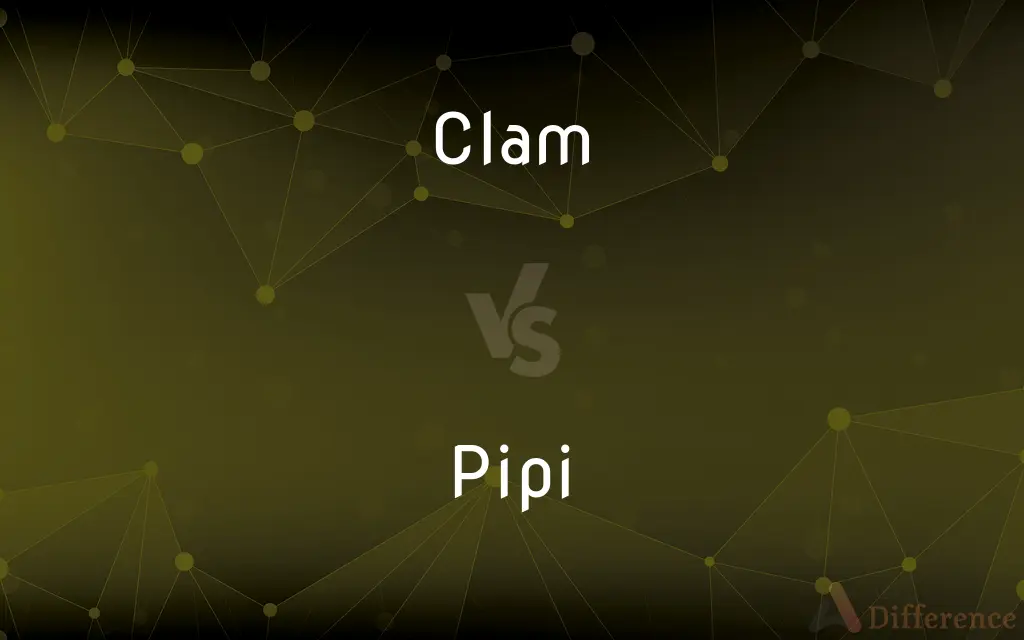Clam vs. Pipi — What's the Difference?
By Tayyaba Rehman & Fiza Rafique — Updated on March 14, 2024
Clams are a broad category of bivalve mollusks found in freshwater and marine environments, known for their distinct shells and soft bodies. Pipis, a type of clam native to Australia and New Zealand, are specifically recognized for their hardy nature.

Difference Between Clam and Pipi
Table of Contents
ADVERTISEMENT
Key Differences
Clams refer to many species of bivalve mollusks that can be found in both freshwater and marine settings around the world. These organisms are characterized by their two-part shells, which protect a soft body inside. They are an important part of aquatic ecosystems, serving as filter feeders that clean the water. Pipis, on the other hand, are a specific type of marine clam (Paphies australis) found primarily on sandy beaches in Australia and New Zealand. They are particularly noted for their ability to burrow deep into the sand and are a popular target for recreational and commercial harvesting.
Clams are versatile and consumed worldwide in a variety of dishes, from clam chowder to pasta sauces. They are valued for their tender meat and are often steamed, fried, or added to soups. Pipis, while also edible, have a more specific culinary niche, often featured in indigenous Australian cuisine and traditional Maori dishes. They can be cooked similarly to other clams but are especially prized for their slightly sweet, rich flavor that distinguishes them from other varieties.
Both clams and pipis are rich in protein, iron, and omega-3 fatty acids, making them a healthy addition to the diet. However, the nutritional content can vary slightly based on their specific environments and diets. Clams, being more widely available, are a staple seafood in many parts of the world, whereas pipis, due to their localized habitat, might not be as readily accessible globally.
In terms of habitat, clams can adapt to a variety of aquatic environments, including brackish waters. They play a crucial role in their ecosystems by filtering water and serving as a food source for numerous predators. Pipis, while also serving as an important part of their ecosystem, are more specialized in their habitat preferences, thriving in the sandy, intertidal zones of beaches where they can often be harvested by hand during low tide.
Despite the differences, both clams and pipis share the common trait of being bivalves with a significant role in culinary traditions, ecosystems, and as a food source. Their distinct characteristics and habitats contribute to their unique places within marine biodiversity and human cuisine.
ADVERTISEMENT
Comparison Chart
Habitat
Freshwater and marine environments
Sandy beaches in Australia and New Zealand
Culinary Use
Versatile, used in various dishes
Featured in indigenous and traditional cuisine; slightly sweet flavor
Nutritional Value
High in protein, iron, omega-3s
Similar, with slight variations based on diet and environment
Availability
Widely available
More localized to Australia and New Zealand
Role in Ecosystem
Filter feeders, improve water quality
Important in sandy beach ecosystems, filter feeders
Compare with Definitions
Clam
Culinary versatility.
Clams are a key ingredient in New England clam chowder.
Pipi
Specific habitat.
Pipis are primarily found on sandy beaches in Australia and New Zealand.
Clam
Ecosystem role.
By filtering water, clams contribute to the cleanliness and health of aquatic habitats.
Pipi
Unique flavor.
Pipis are often enjoyed for their sweet, rich taste in various local dishes.
Clam
Nutritional benefits.
Clams are a low-fat source of protein and rich in minerals.
Pipi
Cultural significance.
Pipis hold a special place in Maori and indigenous Australian culinary traditions.
Clam
Diverse habitats.
Clams can be found in both freshwater and saltwater environments worldwide.
Pipi
Harvesting methods.
Pipis can be collected by hand during low tides, making them a popular choice for beach foraging.
Clam
Broad availability.
Clams are harvested both commercially and recreationally across many regions.
Pipi
Contribution to ecosystem.
Like other clams, pipis serve as filter feeders, playing a vital role in maintaining the health of their sandy beach habitats.
Clam
Clam is a common name for several kinds of bivalve molluscs. The word is often applied only to those that are edible and live as infauna, spending most of their lives halfway buried in the sand of the seafloor or riverbeds.
Pipi
(NZ) The edible saltwater clam Paphies australis, of the family Mesodesmatidae, endemic to New Zealand.
Clam
A marine bivalve mollusc with shells of equal size.
Pipi
The edible saltwater clam Plebidonax deltoides, endemic to Australia.
Clam
A dollar.
Clam
Dig for or collect clams
November is one of the worst times for clamming
Clam
Abruptly stop talking
As soon as I ask if any of this can go on the record, he clams up
Clam
Any of various usually burrowing marine and freshwater bivalve mollusks chiefly of the subclass Heterodonta, including members of the families Veneridae and Myidae, many of which are edible.
Clam
The soft edible body of such a mollusk.
Clam
(Informal) A close-mouthed person, especially one who can keep a secret.
Clam
(Slang) A dollar
Owed them 75 clams.
Clam
A clamp or vise.
Clam
To hunt for clams.
Clam
A bivalve mollusk of many kinds, especially those that are edible; for example pl=s (Mya arenaria), hard clams (Mercenaria mercenaria), sea clams or hen clam (Spisula solidissima), and other species. The name is said to have been given originally to the Tridacna gigas, a huge East Indian bivalve.
Clam
Strong pincers or forceps.
Clam
A kind of vise, usually of wood.
Clam
A dollar.
Those sneakers cost me fifty clams!
Clam
A Scientologist.
Clam
A vagina.
Clam
(slang) In musicians' parlance, a wrong or misplaced note.
Clam
(informal) One who clams up; a taciturn person, one who refuses to speak.
Clam
Mouth (Now found mostly in the expression shut one's clam)
Clam
Clamminess; moisture
Clam
To dig for clams.
Clam
To produce, in bellringing, a clam or clangor; to cause to clang.
Clam
To be moist or glutinous; to stick; to adhere.
Clam
To clog, as with glutinous or viscous matter.
Clam
Clammy.
Clam
A bivalve mollusk of many kinds, especially those that are edible; as, the long clam (Mya arenaria), the quahog or round clam (Venus mercenaria), the sea clam or hen clam (Spisula solidissima), and other species of the United States. The name is said to have been given originally to the Tridacna gigas, a huge East Indian bivalve.
You shall scarce find any bay or shallow shore, or cove of sand, where you may not take many clampes, or lobsters, or both, at your pleasure.
Clams, or clamps, is a shellfish not much unlike a cockle; it lieth under the sand.
Clam
Strong pinchers or forceps.
Clam
A kind of vise, usually of wood.
Clam
Claminess; moisture.
Clam
A crash or clangor made by ringing all the bells of a chime at once.
Clam
To clog, as with glutinous or viscous matter.
A swarm of wasps got into a honey pot, and there they cloyed and clammed Themselves till there was no getting out again.
Clam
To be moist or glutinous; to stick; to adhere.
Clam
To produce, in bell ringing, a clam or clangor; to cause to clang.
Clam
Burrowing marine mollusk living on sand or mud
Clam
A piece of paper money worth one dollar
Clam
Flesh of either hard-shell or soft-shell clams
Clam
Gather clams, by digging in the sand by the ocean
Common Curiosities
How do clams benefit the environment?
Clams act as natural filter feeders, cleaning the water by removing impurities, which helps maintain aquatic ecosystem health.
Can pipis be used interchangeably with other clams in recipes?
Yes, pipis can often substitute for other clams, though they may impart a slightly different flavor profile to dishes.
What are pipis?
Pipis are a specific type of clam found on sandy beaches in Australia and New Zealand, known for their unique flavor.
Are clams good for you?
Yes, clams are a nutritious seafood option, providing high-quality protein, omega-3 fatty acids, and essential minerals like iron.
How are clams harvested?
Clams can be harvested commercially with dredges or rakes and recreationally by hand digging, depending on local regulations and species.
What are clams?
Clams are bivalve mollusks with a two-part shell, found in various aquatic environments and consumed worldwide.
What's the difference between clams and pipis in terms of flavor?
Pipis tend to have a slightly sweeter and richer flavor compared to the broader category of clams, which can vary widely in taste.
Why are clams important to aquatic ecosystems?
Clams play a crucial role in aquatic ecosystems as filter feeders, which helps improve water quality and provides a food source for other marine life.
Where can I find pipis?
Pipis are predominantly found on sandy beaches in Australia and New Zealand, especially in intertidal zones.
What makes pipis a popular choice for beach foraging?
Their abundance on sandy beaches and ease of hand collection during low tide make pipis a favorite among beach foragers in Australia and New Zealand.
Can pipis be found outside of Australia and New Zealand?
While pipis are native to these regions, similar species may be found in similar habitats around the world, but the term "pipi" specifically refers to those found in Australia and New Zealand.
How do I clean pipis before cooking?
Pipis should be rinsed in clean water and soaked to remove any sand inside them before cooking, similar to other clams.
What is a popular way to cook pipis?
Pipis are commonly steamed or boiled and can be seasoned with various herbs and spices, highlighting their sweet, rich taste.
Is there a significant nutritional difference between clams and pipis?
The nutritional content of both clams and pipis is relatively similar, though variations can occur based on their diet and environment.
Can I eat pipis raw?
While pipis can be eaten raw, like other shellfish, they should be thoroughly cleaned and sourced from safe, unpolluted waters to minimize health risks.
Share Your Discovery

Previous Comparison
Canary vs. Parrot
Next Comparison
Principal vs. DirectorAuthor Spotlight
Written by
Tayyaba RehmanTayyaba Rehman is a distinguished writer, currently serving as a primary contributor to askdifference.com. As a researcher in semantics and etymology, Tayyaba's passion for the complexity of languages and their distinctions has found a perfect home on the platform. Tayyaba delves into the intricacies of language, distinguishing between commonly confused words and phrases, thereby providing clarity for readers worldwide.
Co-written by
Fiza RafiqueFiza Rafique is a skilled content writer at AskDifference.com, where she meticulously refines and enhances written pieces. Drawing from her vast editorial expertise, Fiza ensures clarity, accuracy, and precision in every article. Passionate about language, she continually seeks to elevate the quality of content for readers worldwide.














































